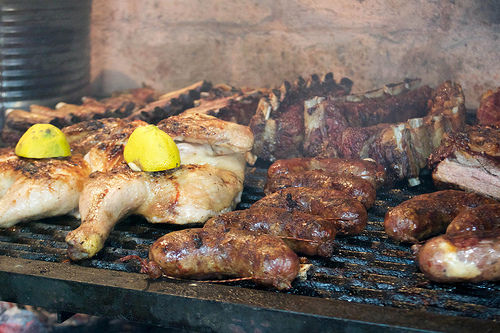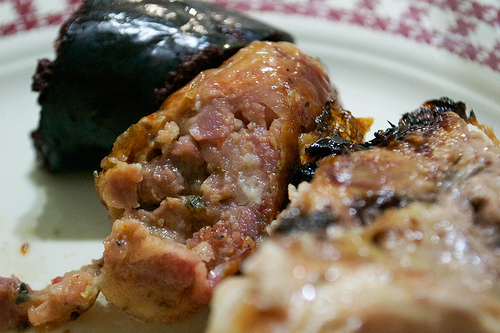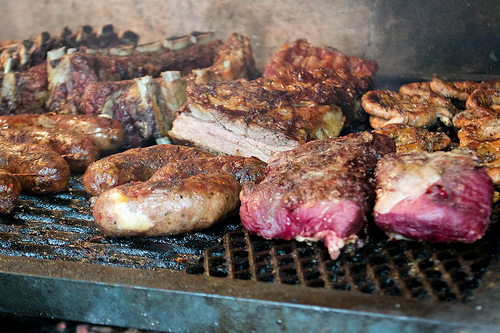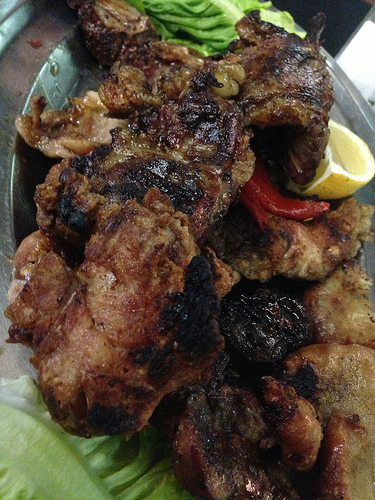Pretty much every country has their version of a barbecue. The South Africans have their braii, East Asia has satay and us Brits even think we’re a dab hand at it, with our row of chipolatas and beefburgers and saucy aprons that Dad generally wears. But talk to an Argentinian about asado and they’ll get passionate about it. They might even invite you over for one. I ate asado just about every third day while I was over there. It’s an art form, a competitive sport, almost. And whether you visit a parrilla to eat it, or enjoy it at someone’s home, you mustn’t miss out on it.
It goes without saying that at an asado you’re going to eat some beef (you’re in Argentina), but it might not be in chunky steaks, like you’re used to at home. Vacio (pronounced vass-ee-oh) is a cut of beef without bones, the nearest you’ll get to a chunk of steak. Entraña (ent-tran-ya) is from the tummy area of the cow, tender and very tasty, with a little sinew which is rendered down after long, slow cooking. And you’ll eat ribs – known as costillar (cost-ee-szj-ah) juicy chunks of beef with the short rib bone still in; smoky, dark and cooked until just pink in the middle.
 |
| On the asado: left-right: costillar (ribs), chicken, chorizo and vacio on the right hand side at the back |
Chicken legs and breasts are cooked on the asado until the skin is crispy and blackened and the flesh inside is pale and juicy. Chicken breast meat can have a tendency to dry out on the asado so a special eye is kept on it to catch it when it’s just cooked. At the parrilla, the chicken had a really delicious, smoky flavour as a result of the coals. Gorgeous with a spoonful of chimichurri or criolla salsa to add moisture as well as sharpness.
Black pudding, but completely different from the stuff served in the UK. Its black, thick skin isn’t often eaten (although some people like it) and the centre is scraped out and eaten with other meats (chicken goes well with it) and a juicy salad. Morcilla (pronounced mor-SEE-jza) is very soft in the centre and the big white lumps of fat (typical of British versions) are absent. The flavour of morcilla is dense and very rich. You’ll either love it or you’ll hate it. But you have to try it.
These are nothing like their Spanish, paprika-scented namesakes. Argentine chorizo is a densely-packed, coarse, meaty sausage, usually made from pork or beef. A stubby little sausage with a crisp skin, but looks can be deceiving: the little fellas are actually very filling. Wonderful as they are or cut in slices and added to stews. My husband’s uncle, who lives in Fiorito, just a few blocks from where Maradona was born, handed me a choripan: chorizo sliced in half lengthways and stuffed into a split crusty bread roll: one of the best sausage sandwiches of my life. Chorizo can be flavoured with chilli or pepper flakes, roquefort cheese or they’re often just left plain.
Suckling pig, pronounced ‘lech-ON’. Roasted over coals, whole, until cooked through and very juicy. Pork at it’s juiciest and most tender. This will be cut into chunks and passed around on a platter, and leftovers are eaten cold with salads the next day.
Kidneys – sweet and flavourful, although the ones I tried at the parrilla were a tad over done and a bit chewy and dry. Pronounce them ‘rin-yon-ez‘. I was assured that they’re often served not just as they are, but with a salsa, such as chimichurri, or with lemon juice, garlic and parsley.
Chinchulin (‘chin-choo-lin‘) was the one thing (apart from politics, which was best not mentioned) that I found even divided Argentinians. Some love it, and others hate it. When cooked, it has the appearance of a small, curly little sausage and it’s basically grilled intestines. It’s best cooked slowly until crispy, but has a fairly bitter flavour and once you bite into it, and the appearance of a very hollow, thin sausage. The texture was good, something I could imagine nibbling on in front of a film, but the flavour a little too bitter for my liking.
If you’re offered something at an asado that has the appearance and texture of a chargrilled lump of white fat, don’t worry. It’s probably molleja (pronounced mozjs-ekh-ah), or in other words chargrilled glands. They don’t have a particularly strong flavour, other than the chargrilled outside, but it’s the texture that people go for. It’s pale, kind of sweet, and a for a lot of Argentinians, it’s one of the stars of the asado. My nephew makes it with a parsley, garlic and lemon topping.
Lamb is eaten in Argentina but not as widely as beef. I gather that’s because it’s expensive, but it can be cooked whole on the asado until tender. I’ve been promised this next time we visit by my husband’s uncle Benicio, a perfect excuse to start planning another trip next year, perhaps?




I am going to have to try this one day.
ReplyDelete